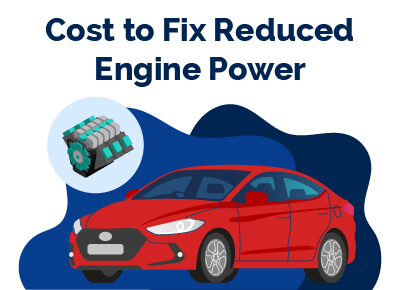How Much Does It Cost To Fix Reduced Engine Power?
July 12, 2023


Chris is Head of Content for FindTheBestCarPrice and is based out of Philadelphia, PA. As a seasoned automotive industry analyst and car enthusiast, he ensures the highest level of quality across all our content and curates our picks for the best deals each month.
Chris studied information systems and marketing at Drexel University and writes about a wide range of topics ranging from car buying tips to troubleshooting common mechanical issues.
When he’s not thinking about cars, he likes to stay in with his dog and make an “attempt” to finish a crossword puzzle (he’s not quite at the Saturday/Sunday level…yet). As a former cheesemonger, Chris still has a “sharp” passion for all things cheese, and his fridge is always loaded with it!
Chris also has a passion for things that go fast, and drones are no exception. He spends some of his time writing for Dronesourced.
For your car’s engine to deliver subpar performance, it means one or more components have gone bad, worn out, or broken. You have to inspect the engine, find those components, and have them fixed or replaced for the engine to run smoothly again. How much does it cost to fix reduced engine power?
The cost depends on what caused the “reduced power.” Some engine components can cost as low as $100 to get fixed, while there are some that cost up to $1,000 or more to get fixed or replaced. So, you should expect to pay between $100 and $1,000 to clear that “Engine Power is Reduced” notice on your car’s dashboard.
In this article, we will discuss, in detail, what causes reduced engine power and exactly what it costs to get it fixed!
Table of Contents
What Does “Reduced Engine Power” Mean?
Modern cars come with pretty much-advanced tech and a connected dashboard that instantly notifies you about any slightest issue with your car.
When the ECU or PCM, which is the car’s central computer, notices that there’s a problem with one or more of the core engine components, it’d throw a check engine light or illuminate the dashboard icon related to the indicated issue.
Similarly, if the central computer detects that engine power has reduced from the normal, it’d show an “Engine Power is Reduced” notification. Well, for some cars, the notification may appear in another wording or format, but the main thing is that you’d understand the system is trying to tell you that your car’s engine isn’t running as effectively as supposed. There can be several causes of reduced engine power.
If your car also goes into “Limp Mode” or prints a limp mode notification on the dashboard cluster, it is also a sign of reduced engine performance. Limp mode means that your car’s engine isn’t running with high efficiency as designed.
So, generally, the reduced engine notification or limp mode means that the ECU – Engine Control Unit – has detected poor performance.
While you could still drive with the notification, it is necessary that you find out what caused the reduced performance and fix it before the issue skyrockets into a bigger engine failure problem.
More so, even without the “engine power reduced” notification, if you’re driving and notice that your car isn’t speeding as usual, you should get it diagnosed and serviced/fixed.
What Causes Reduced Engine Power?
There could be many possible reasons why you’re getting that notification. Apparently, if any of the core engine components gets faulty, the engine’s performance will be affected – this is a no-brainer.
From sensor failures to module failures and loose belts – all these can trigger the Powertrain Control Module (PCM) or Engine Control Unit (ECU) to show a reduced engine power notification. Hereunder are some common reasons for reduced engine power; these “reasons” also apply to limp mode.
- Clogged or removed catalyst converter
- Defective throttle position (TP) sensor
- Faulty oxygen sensor
- Loose or damaged wiring in the ECU housing or any other vital area of the engine
- Defective accelerator pedal position (APP) sensor
- Faulty throttle body
- Erratic PCM or ECU readings due to faulty wiring or broken sensors.
- Any fault/error/damage to a core engine or drivetrain component
- Any fault/error/damage in the emissions system
These are the commonest causes of the “engine power reduced” notification. Also, if there’s damage in the transmission or throttle assembly, it could trigger this notification too. In other words, any error or fault that can affect the drivability of a car will cause the PCM/ECU to throw up the “Reduced Engine Power” notification.
Now, how do you fix this? Since there’s a wide range of possible causes, you need to first run a diagnostic test to ascertain what is causing the abysmal notification. Only when you have identified the cause would you be able to know the best measures to take to correct the issue.
How Much Does It Cost To Fix Reduced Engine Power?
Fixing this issue starts with running a comprehensive diagnostic test to know what exactly went wrong. A “Reduced Engine Power” notification diagnostic test costs around $50 to $80, depending on where you went to get it done. If you have and know how to read an auto scanner, you may run the diagnosis yourself and find the faulty component.
You may also need to physically inspect the wiring works done in the engine bay, along with the housings that protect some of the important engine components. Check for cracks on the housing assemblies and loose joints/wiring. If you could find errors during a physical check, apparently, those affected components need to be replaced or fastened back.
Now, depending on the results from your diagnostic tests and physical inspections, that would determine how much you’d spend to fix the issue. Minor issues like sensor replacement, re-wiring, fastening of loose components, and other little fixes can cost from $100 to $1,000. But major issues like CAT replacement may cost up to $1,500.
Also, your location and the workshop or mechanic you’re engaging to fix the issue all add up to determine the amount you pay. You may want to get different quotes from different mechanics and workshops to decide which is the best and more affordable option to go with.
In some cases, all you need to do is to reset the PCM or ECU, and the notification goes out of your car’s dashboard - this doesn’t cost a dime if you already have an auto diagnostic test tool like the OBDII scanner. So, apparently, you should budget $2,000 for this issue - you may have some good bucks left.
Best Car Deals by Category
Frequently Asked Questions
Can you drive with reduced engine power?
Yeah, sure. You can keep driving with the “reduced engine power” notification showing on your car’s dashboard. But even though you could still drive with the warning, that’s not recommendable - you should actually seek to know why the notification came on and fix it as early as possible before it escalates.
Can I reset the “reduced engine power” light myself?
Yes, it is possible to reset the light - maybe the ECU threw it up due to a glitch. So, in this case, after you have checked the engine and nothing seems unusual, you should reset the ECU by disconnecting the car’s battery for some minutes or using a diagnostic tool.
Is reduced engine power serious?
Depending on what caused the notice to appear, it may be serious, or it may not, but either way, you should take it seriously. The reduced engine power warning light indicated that the fuel/air or oil supply into the engine had dropped below the recommended levels. Allowing such a situation to linger could cause fatal engine damage.
Posted in Car Buying Tips, Car Troubleshooting |




